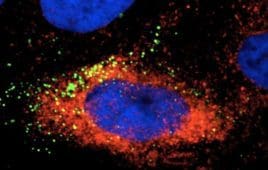
Cellular Protein a Target for Zika Control
A Naturally Occurring Antibiotic Active Against Drug-Resistant Tuberculosis
A naturally occurring antibiotic called kanglemycin A is effective against Mycobacterium tuberculosis, the bacteria that cause tuberculosis, even in drug-resistant strains, according to an international team of researchers who used chemistry, molecular biology, microbiology, and X-ray crystallography to show how the compound maintains its activity. A paper describing the research appears September 20, 2018 in…
Family Genetics Vital For Understanding Autism Progression
Scientists Use CRISPR to Improve Cacao Trees, Key to Chocolate
Use of the powerful gene-editing tool CRISPR-Cas9 could help to breed cacao trees that exhibit desirable traits such as enhanced resistance to diseases, according to Penn State plant scientists. The cacao tree, which grows in tropical regions, produces the cocoa beans that are the raw material of chocolate. Reliable productivity from cacao plants is essential…
Understanding The Future Of Infectious Disease Through Climate Change
Over the past 34 years, rainfall in Uganda has decreased by about 12 percent even though many of the global climate models predict an increase in rainfall for the area, according to an international team of researchers. Rainfall levels in Uganda impact agriculture, food security, wildlife habitats and regional economics as well as the prevalence…
Extracellular Vesicles Could be Personalized Drug Delivery Vehicles
Creating enough nanovesicles to inexpensively serve as a drug delivery system may be as simple as putting the cells through a sieve, according to an international team of researchers who used mouse autologous — their own — immune cells to create large amounts of fillable nanovesicles to deliver drugs to tumors in mice. Nanovesicles are…
Extracellular Vesicles Could be Personalized Drug Delivery Vehicles
Creating enough nanovesicles to inexpensively serve as a drug delivery system may be as simple as putting the cells through a sieve, according to an international team of researchers who used mouse autologous — their own — immune cells to create large amounts of fillable nanovesicles to deliver drugs to tumors in mice. Nanovesicles are…
Identifying the Mechanisms for a New Class of Antiviral Drugs Could Hasten Their Approval
New research shows that a new class of antiviral drugs works by causing the virus’ replication machinery to pause and backtrack, preventing the virus from efficiently replicating. This discovery, made possible by a high-throughput experimental technique called “magnetic tweezers,” could speed the development and approval of related antiviral drugs. A paper describing the research by…
Ingesting Soy Protein May Ease Severity of IBD
Drug Combination Delivered By Nanoparticles May Help in Melanoma Treatment
New Strategy for Antidepressant Therapies
Increasing the activity of the neurotransmitter GABA in the brains of depressed mice has antidepressant effects Experimentally increasing the activity of a subclass of nerve cells that produce the neurotransmitter gamma-aminobutyric acid (GABA) has antidepressant effects similar to pharmaceutical antidepressants in depressed mice. The discovery lends new credence to the idea that GABA-enhancing drugs could…










